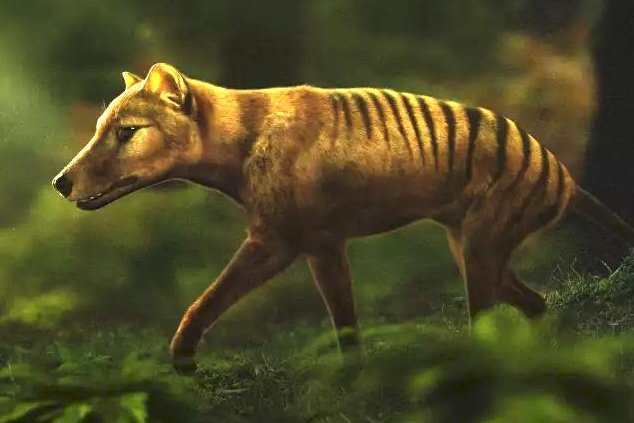
Colossal Biosciences announces it has started working to "de-extinct" the Tasmanian tiger, with plans to re-introduce the species within the next decade to its native Tasmania and Australia. Image courtesy of Colossal Biosciences
Aug. 16 (UPI) -- Like something out of Jurassic Park, a Dallas-based genetics company announced Tuesday it is working to resurrect Australia's extinct Tasmanian tiger, also known as the thylacine, to slow biodiversity loss and climate change.
Colossal Biosciences, which is already using genetic engineering to "de-extinct" the woolly mammoth, announced Tuesday it has the DNA and $10 million in funding for its second de-extinction project with the Tasmanian tiger -- the world's largest carnivorous marsupial, before it died off almost a century ago.
The Tasmanian tiger, which was native to Australia, Tasmania and New Guinea, appeared about 4 million years ago and went extinct as a result of hunting by humans. The last known thylacine died in 1936, with the species officially declared extinct in 1982.
Colossal's goal is to reintroduce a genetically-modified hybrid Tasmanian tiger, within the next decade, into parts of Australia to hunt non-native predators that prey on native herbivores in an attempt to re-balance the ecosystem.
Colossal's plan to de-extinct the woolly mammoth would reintroduce that ancient species to the Arctic to slow the permafrost melt.
"From a Colossal perspective, we are interested in pursuing de-extinction projects where the reintroduction of the restored species can fill an ecological void that was created when the species went extinct and help restore the degraded ecosystem," Ben Lamm, Colossal's co-founder, told Newsweek.
Colossal's other co-founder, George Church, is a renowned Harvard geneticist who has been dubbed the "father of synthetic biology."
Church and Lamm are working with Andrew Pask, a professor of evolutionary biology at the University of Melbourne, who was the first to decode the thylacine genome in 2017.
Using the DNA, the scientists plan to take cells from a close-living relative, like the fat-tailed dunnart, and edit the differences to create a thylacine embryo.
"We're interrogating every single part of the thylacine genome," Pask said. "It's an expensive and time-consuming endeavor, but now we can figure out those essential DNA edits we need to make that thylacine."
While Pask says it starts with one Tasmanian tiger, the goal is to rewild the ecosystem.
"To bring a healthy population of thylacines back, you can't bring back one or five," Pask said. "You're looking at bringing back a good number of animals that you can put back into the environment."
Pask argues biotechnology is vital to speed the process of balancing the ecosystem, as current conservation techniques are not enough to save threatened species.
"We have to look at other technologies and novel ways to do that if we want to stop this biodiversity loss," Pask said. "We have no choice. I mean, it will lead to our own extinction if we lose 50% of biodiversity on Earth in the next 50 to 100 years."
No comments:
Post a Comment